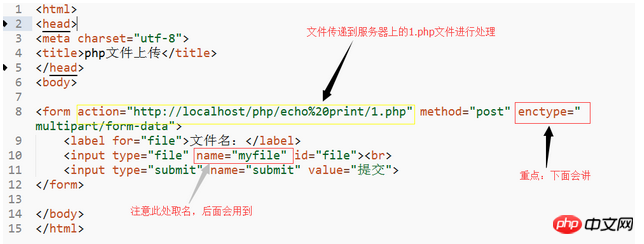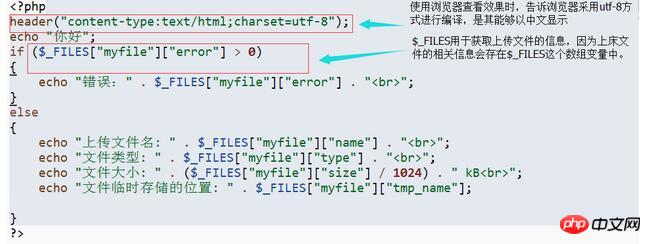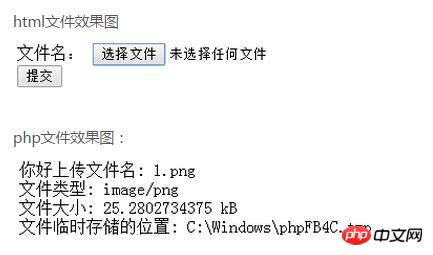Detailed explanation of file upload in php
Have you really mastered php file upload technology? This article has compiled relevant information on PHP file uploading for everyone. It has certain reference value. Interested friends can refer to it.
First of all, let me state that this chapter has a lot of content and is relatively difficult. , you have to have an attitude of fighting with yourself. Don’t miss the subtleties, practice more and more is the way to go.
Learning is like climbing a mountain. You have to do it step by step. First, set a small goal for yourself, and then continue to climb higher and higher, and finally reach the top.
Please consider the above two pieces of advice carefully
1. Description of my preparations.
Editor: sublime text3 (Which editor you use depends on your preference)
Server build: Use phpstudy2014 to build the server. The server file is stored in the www file on the D drive of my computer. (Installing phpstudy will automatically generate the www file, you decide which disk to install it on). Run phpstudy and enter localhost in the browser address bar to access files on the server.
The process of uploading files: The browser uploads the file on the client, click submit, the file is sent to a php file in the server for processing, and the php uploads the file Save the file to the server.
2. Create the form
Please see my html code

1. application/x-www-form-urlencoded: Form data is encoded as name/value pairs. This is a standard encoding format.
2. multipart/form-data: Form data is encoded as a message, and each control on the page corresponds to a part of the message.
3. text/plain: The form data is encoded in plain text, without any controls or formatting characters.
Supplement (just take a look): The enctype attribute of ORM is the encoding method. There are two commonly used ones: application/x-www-form-urlencoded and multipart/form-data. The default is application/x-www-form. -urlencoded. When the action is get, the browser uses the x-www-form-urlencoded encoding method to convert the form data into a string (name1=value1&name2=value2...), and then appends the string to the end of the url, splits it with ?, and loads it. this new url. When the action is post, the browser encapsulates the form data into the http body and then sends it to the server. If there is no type=file control, just use the default application/x-www-form-urlencoded. But if there is type=file, multipart/form-data will be used. The browser will divide the entire form into control units, and add Content-Disposition (form-data or file), Content-Type (default is text/plain), name (control name) and other information to each part, and Add delimiter (boundary).
In short, remember two sentences: if there is type=file in the input tag, then enctype=multipart/form-data. If there is no type=file, application/x-www-form-urlencoded is generally used.
When uploading files, the data must undergo certain transformations before they can be uploaded to the server. The difference between application/x-www-form-urlencoded and multipart/form-data is the conversion encoding method.
3. Create a php file to process the uploaded files.


FILES["myfile"]["error"]=1 The uploaded file exceeds the server limit, such as exceeding the server space size. _FILES["myfile"]["error"]=2 exceeds the browser limit for uploading $_FILES["myfile"]["error"]=3 Only part of the file is uploaded
Upload limit
Normally, the server usually limits the size or type of files uploaded by the server. We add restrictions on the uploaded file code based on the above php code.
First familiarize yourself with the usage of several functions:
explode()The function is used to split strings. For example: explode(“.”,”aaa.HTML”) is to divide this at the position of the dot. The string is divided into two strings, "aaa" and "HTML", and these two strings are stored in the same array in order.
end()Get the value of the last element in the array.
in_array() Search for an element in the array to see if it exists. It returns true if it exists and false if it does not exist.
1 2 3 4 5 6 7 8 9 10 11 12 13 14 15 16 17 18 19 20 21 22 23 24 25 26 27 28 29 30 31 32 33 34 35 36 37 |
|
4. Save the uploaded file
After the file is uploaded, it is saved in a temporary location. It will disappear when the script ends. If we want to save it permanently on the server, we need to save it in another location.
. file_exists("upload/" . FILES["file"]["name"]) checks whether the file or directory exists. .moveuploadedfile(_FILES["file"]["tmp_name"], "upload/" . $_FILES["myfile"]["name"]);Move the uploaded file from the temporary location to the server space.
1 2 3 4 5 6 7 8 9 10 11 12 13 14 15 16 17 18 19 20 21 22 23 24 25 26 27 28 29 30 31 32 33 34 35 36 37 38 39 40 41 42 43 44 45 46 47 |
|
The above is the entire content of this article, I hope it will be helpful to everyone's study.
Related recommendations:
How to combine two photos of the front and back of an ID card into one picture using PHP
PHP uses SWOOLE extension to implement scheduled synchronization of MySQL data
##PHP summary of object knowledge
The above is the detailed content of Detailed explanation of file upload in php. For more information, please follow other related articles on the PHP Chinese website!

Hot AI Tools

Undresser.AI Undress
AI-powered app for creating realistic nude photos

AI Clothes Remover
Online AI tool for removing clothes from photos.

Undress AI Tool
Undress images for free

Clothoff.io
AI clothes remover

Video Face Swap
Swap faces in any video effortlessly with our completely free AI face swap tool!

Hot Article

Hot Tools

Notepad++7.3.1
Easy-to-use and free code editor

SublimeText3 Chinese version
Chinese version, very easy to use

Zend Studio 13.0.1
Powerful PHP integrated development environment

Dreamweaver CS6
Visual web development tools

SublimeText3 Mac version
God-level code editing software (SublimeText3)

Hot Topics
 1662
1662
 14
14
 1418
1418
 52
52
 1311
1311
 25
25
 1261
1261
 29
29
 1234
1234
 24
24
 How do you parse and process HTML/XML in PHP?
Feb 07, 2025 am 11:57 AM
How do you parse and process HTML/XML in PHP?
Feb 07, 2025 am 11:57 AM
This tutorial demonstrates how to efficiently process XML documents using PHP. XML (eXtensible Markup Language) is a versatile text-based markup language designed for both human readability and machine parsing. It's commonly used for data storage an
 Explain JSON Web Tokens (JWT) and their use case in PHP APIs.
Apr 05, 2025 am 12:04 AM
Explain JSON Web Tokens (JWT) and their use case in PHP APIs.
Apr 05, 2025 am 12:04 AM
JWT is an open standard based on JSON, used to securely transmit information between parties, mainly for identity authentication and information exchange. 1. JWT consists of three parts: Header, Payload and Signature. 2. The working principle of JWT includes three steps: generating JWT, verifying JWT and parsing Payload. 3. When using JWT for authentication in PHP, JWT can be generated and verified, and user role and permission information can be included in advanced usage. 4. Common errors include signature verification failure, token expiration, and payload oversized. Debugging skills include using debugging tools and logging. 5. Performance optimization and best practices include using appropriate signature algorithms, setting validity periods reasonably,
 Explain late static binding in PHP (static::).
Apr 03, 2025 am 12:04 AM
Explain late static binding in PHP (static::).
Apr 03, 2025 am 12:04 AM
Static binding (static::) implements late static binding (LSB) in PHP, allowing calling classes to be referenced in static contexts rather than defining classes. 1) The parsing process is performed at runtime, 2) Look up the call class in the inheritance relationship, 3) It may bring performance overhead.
 PHP Program to Count Vowels in a String
Feb 07, 2025 pm 12:12 PM
PHP Program to Count Vowels in a String
Feb 07, 2025 pm 12:12 PM
A string is a sequence of characters, including letters, numbers, and symbols. This tutorial will learn how to calculate the number of vowels in a given string in PHP using different methods. The vowels in English are a, e, i, o, u, and they can be uppercase or lowercase. What is a vowel? Vowels are alphabetic characters that represent a specific pronunciation. There are five vowels in English, including uppercase and lowercase: a, e, i, o, u Example 1 Input: String = "Tutorialspoint" Output: 6 explain The vowels in the string "Tutorialspoint" are u, o, i, a, o, i. There are 6 yuan in total
 What are PHP magic methods (__construct, __destruct, __call, __get, __set, etc.) and provide use cases?
Apr 03, 2025 am 12:03 AM
What are PHP magic methods (__construct, __destruct, __call, __get, __set, etc.) and provide use cases?
Apr 03, 2025 am 12:03 AM
What are the magic methods of PHP? PHP's magic methods include: 1.\_\_construct, used to initialize objects; 2.\_\_destruct, used to clean up resources; 3.\_\_call, handle non-existent method calls; 4.\_\_get, implement dynamic attribute access; 5.\_\_set, implement dynamic attribute settings. These methods are automatically called in certain situations, improving code flexibility and efficiency.
 PHP and Python: Comparing Two Popular Programming Languages
Apr 14, 2025 am 12:13 AM
PHP and Python: Comparing Two Popular Programming Languages
Apr 14, 2025 am 12:13 AM
PHP and Python each have their own advantages, and choose according to project requirements. 1.PHP is suitable for web development, especially for rapid development and maintenance of websites. 2. Python is suitable for data science, machine learning and artificial intelligence, with concise syntax and suitable for beginners.
 PHP in Action: Real-World Examples and Applications
Apr 14, 2025 am 12:19 AM
PHP in Action: Real-World Examples and Applications
Apr 14, 2025 am 12:19 AM
PHP is widely used in e-commerce, content management systems and API development. 1) E-commerce: used for shopping cart function and payment processing. 2) Content management system: used for dynamic content generation and user management. 3) API development: used for RESTful API development and API security. Through performance optimization and best practices, the efficiency and maintainability of PHP applications are improved.
 PHP: A Key Language for Web Development
Apr 13, 2025 am 12:08 AM
PHP: A Key Language for Web Development
Apr 13, 2025 am 12:08 AM
PHP is a scripting language widely used on the server side, especially suitable for web development. 1.PHP can embed HTML, process HTTP requests and responses, and supports a variety of databases. 2.PHP is used to generate dynamic web content, process form data, access databases, etc., with strong community support and open source resources. 3. PHP is an interpreted language, and the execution process includes lexical analysis, grammatical analysis, compilation and execution. 4.PHP can be combined with MySQL for advanced applications such as user registration systems. 5. When debugging PHP, you can use functions such as error_reporting() and var_dump(). 6. Optimize PHP code to use caching mechanisms, optimize database queries and use built-in functions. 7




